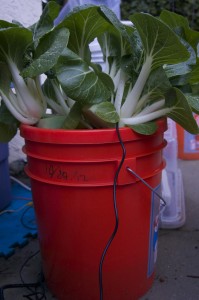Aeroponics is the science and art of growing plants without soil in an air based environment. We decided to experiment with this growing style, and built a fairly simple system. Our system includes foam, seedlings, nutrients, a fogger, and a Homer’s All Purpose Bucket with a lid. Two gallons of water, with the nutrients mixed in, sit at the bottom of the bucket. The fogger disk vibrates water at 4 megahertz, and fills the air with microscopic drops (5-10 microns). Root pores then absorb the nutrients and water from the droplets. This allows for very controlled amounts of nutrients to be dispensed to plants. There are three main nutrients that the plant needs. Nitrogen helps plants grow and stay green. Phosphorus make the plants bloom. Potassium helps the structure of the plant stay stronger.
There are numerous benefits of aeroponics over soil based gardening. With this system, you, the user, have complete control over the plant environment. You can have management of the nutrient concentration and composition, moisture, and even the diseases that can ham or kill the plant. The system can also have an extremely small footprint. It uses less water, fertilizers, and no pesticides. In fact, in a study conducted by NASA, aeroponic systems were found to use 98% less water than regular gardening. These systems also speed up plant growth to thirteen crop turns per year in aeroponics versus five crop turns in soil per year.
Even though aeroponics is extremely beneficial, there are a few things to watch out for. To protect against buildup of mineral salts, algae, and mildew growth, you need to clean the root chamber (bucket) regularly. There is also a dependence on the system, meaning that within minutes of the fogger failing, the plants will wilt. You also need a certain level of competency in running an aeroponic system. Knowledge of nutrient amounts required by your plant is essential, because you don’t have any soil to absorb excess/wrong nutrients supplied.
Some helpful links:
http://en.wikipedia.org/wiki/Hydroponics
http://www.nasa.gov/missions/science/biofarming.html
http://www.nasa.gov/audience/foreducators/9-12/features/aquaponics.html
http://www.nasa.gov/offices/ipp/centers/kennedy/success_stories/Inflatable_Aeroponic_System_BBlinds.html
http://generalhydroponics.com/site/index.php/products/nutrients/flora_series/
